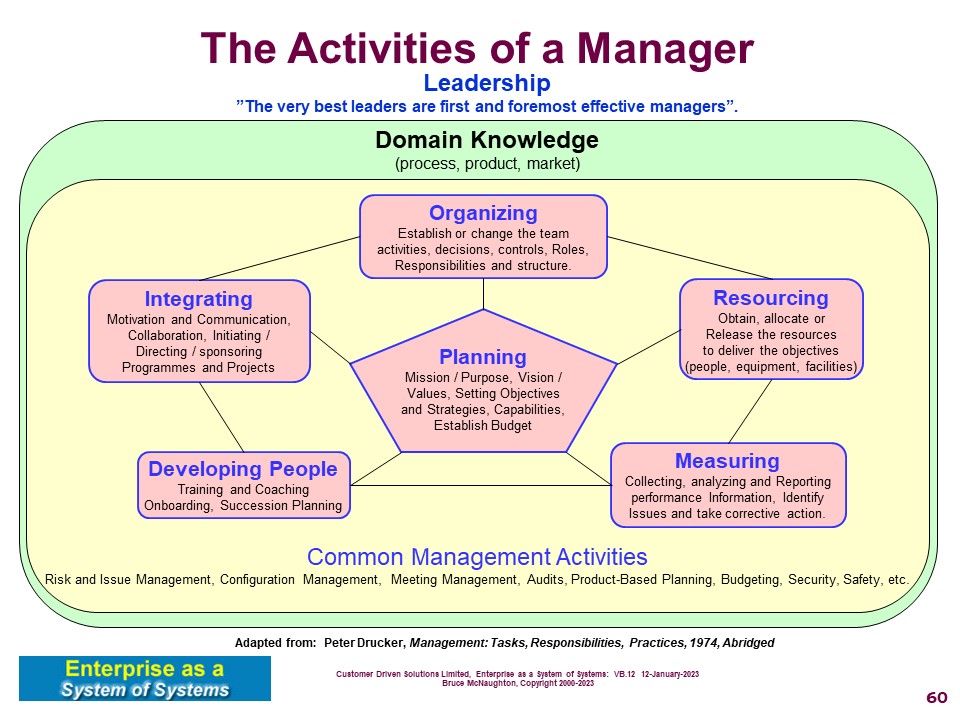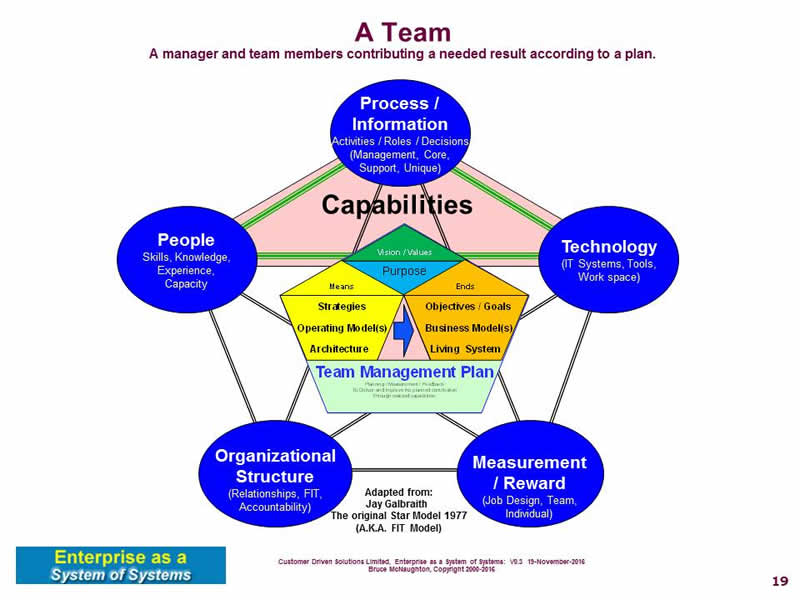Management Capabilities
Overview
The Management Capabilities are the first capabilities created for an organization. These capabilities are developed and formalized as the organization continues to mature. The Management Capabilities create all of the other capabilities in the organization.
The primary purpose of any organization is the delivery of products and services that meet or exceed customer needs (delight the customer). This continued focus for the organizations ensures a sustainable future.

The activities of a manager are carried out in every team using the Team Performance Management capability (based upon the process design pattern). See the picture of a team below.

The typical Management capabilities are based upon the following management processes in the process model:
The organization is established by carrying out the activities of a manager at all levels in the organization.
Purpose
The purpose of the set of management capabilities is:
- To identify the purpose, objectives and plans of the organization.
- To establish the teams to deliver the purpose
- To create the innovation and delivery capabilities
- To create the delivery and operation capabilities
- To obtain and allocate resources to deliver the purpose.
Performance
The following are types of performance measures for the management capability:
- Time to purchase an item
- Time to establish a new team (or remove a team).
- Time and accuracy of the planning process
- Time to recruit and select an employee
- Time to recruit and select a contractor
- Number of corrective actions raised at Audits
- number of corrective actions still open after a third audit.
- etc.
None of the above objectives can be met by a single team. There is always some cross team collaboration to achieve the objectives.
Resources
Additional resources may be required to support the managers carry out their activities. The following organizations provide direct support to managers to carry out these activities:
- HR
- Finance
- IT
- Procurement (Purchasing)
- Enterprise / Business Architecture or Organizational Design Teams
- Planning Teams
These are defined based upon the forecast workload and the needs of the managers.
Design Elements
The following are example operating model structures that can be created from the Management Capability:
- Small IT and Consulting Business.
- Product Line Organization.
- Divisional Organization.
- Franchise Organization.
The processes are identified and based upon patterns, their high level design is created.
In addition, the design of the processes related to the management capability are designed and created to be used to help bootstrap the capabilities into the organization.
The design elements lend themselves to a multi-disciplined team with representatives from HR / OD, Quality, Finance, IT, and Enterprise / Business Architects.
- NOTE: Based upon Russell Ackoff's Idealized Design. See thoughts on: Management Capability Idealized Design
- (NOTE: the UK ONS has an organization that looks similar to the Idealized Design: Capability and Performance)
In general any additional management practices or tools would also be designed for this (or outsourced) as appropriate.
These management practices will start to be used as soon as they are ready for use.
The managers in an organization carry out their management practice to achieve the following:
- Planning to carry out the mission of the organization and deliver their contribution to the achievement of the organizations objectives.
- Organizing to ensure the most effective management and team organization to carry out the necessary activities to deliver the mission.
- Resourcing Obtain, Allocate and release resources according to the organization design and plans (objectives) for their area
- Integrating their team within the management function to collaborate, communicate and motivate.
- Measuring the performance of their team within the organization
- Develop people to achieve their maximum potential and ensure continued capability for the future.
By performing the 6 activities of management practice, the managers create a management capability to guide the organization towards the vision and provide products and services to customers.
In addition, key customers, suppliers and stakeholders are identified. Other external stakeholders (such as local / global governments, banks, shareholders, etc).
Domain knowledge is an important aspect of management practice. This is generally developed through working in industry in various positions.
NOTE: there are a number of common management activities that support the above 6 activities: (Used when needed).
Management Capabilities
The management capabilities (whole management capability area) are based upon the following processes:
- Organization Plan and Review (from Strategy Safari and the 10 schools of strategy)
- Organization Design (or Organization Development)
- Team Performance Management (including budgeting and change management)
- Procurement
- Asset Management (End to End including purchasing)
- Portfolio Management
- Programme Management Process Design Pattern
- Project Management
- Develop People (End to End)
- Facilities Management (end to end)
- Business Management (Product Line Management or P/L Management)
- Product Management (Product / Service :: end to end)
- Risk Management (though do not recommend ... risk is 24/7 and part of all capabilities)
- Capability Innovation Life Cycle
- Continual Management System Improvement
- ICT Service Management
Enterprise and Business Architecture Capabilities
<Consolidate into processes>
- Architecture Description Frameworks and Descriptions
- Organization Models (capability, process, structure, team / people)
- Information Systems Models (application, data, technology)
- Dependency Management
- Stakeholder analysis
- Gap Analysis and Requirements definition
- Trend analysis
- Competitive Analysis
